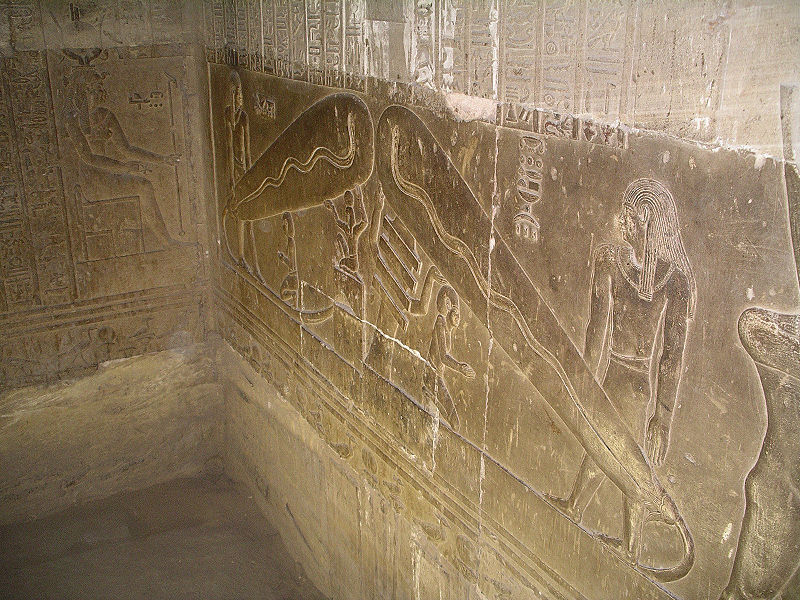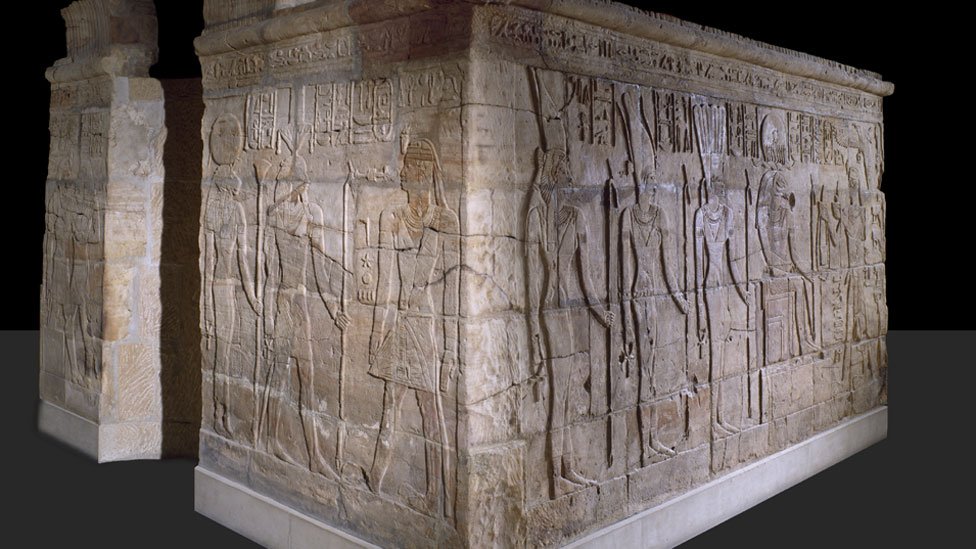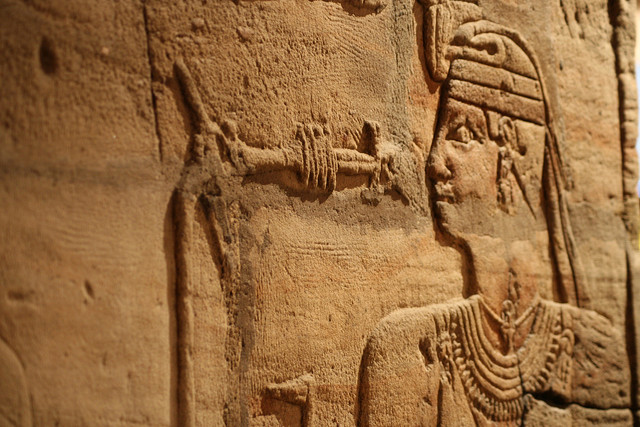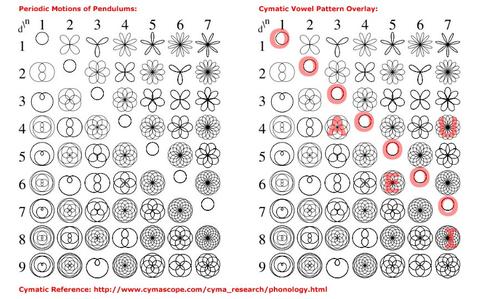It looks like you're using an Ad Blocker.
Please white-list or disable AboveTopSecret.com in your ad-blocking tool.
Thank you.
Some features of ATS will be disabled while you continue to use an ad-blocker.
share:
reply to post by snoopy11
Like this you mean !! chanting in the pyramid shown with cymatics
A Greek traveler, Demetrius, circa 200 B.C., wrote that the Egyptians used vowel sounds in their rituals:
"In Egypt, when priests sing hymns to the Gods they sing the seven vowels in due succession and the sound has such euphony that men listen to it instead of the flute and the lyre."
Like this you mean !! chanting in the pyramid shown with cymatics
Klassified
reply to post by Wolfenz
Interesting you would post these...
One of our ex long time members, whose name started with a Z, had a particular interest in whatever that object is in the photos. If I remember correctly, he felt it was possible this device was for speaking into. Don't know if he was right, but it is interesting that any time I've seen images of this "staff?", it is usually near someones mouth. Obviously, that isn't conclusive, but it is curious. Especially the second image.
If you Look close enough it look like a kinda sorta microphone speaking device
next to the Dendera light bulb ..

heres another ? questionable

OK now something up im seeing this device all over now!!
The Shrine of Taharqa-ashmolean


Well what does experts of Egyptology say ?? LOL ???
the member I would assume is Zorgon ... and your right mostly near the mouth.. so obviously is a device of some kind ... but what for !! ?? any experts here!! ?? I would like to Know ??
reply to post by SLAYER69
I find this very interesting
from your link
cymascope.com
I know that Stonehenge has never been enclosed by walls or a ceiling, which goes against the Resonance possibility in certain ways.
I just cant seem to divert my thoughts to any other theories of why they 'ring'.
I have strong beliefs that our ancestors (at least the mystery/secret groups) were privy to these functions.
We know Resonance heals, a prime example being a Cathedral which uses a pipe organ to produce similar healing qualities threw vibrations.
So whats the list upto know on Stonehenges purposes?
The more we find out, the bigger the hole gets! - I love it!
I find this very interesting
from your link
between 5-10 percent of the rocks ‘ring’ when hit
Resonance may be the most important principle of sound healing and has various definitions. In the context of healing humans or animals it can be described as the frequency of vibration that is most natural to a specific organ or system such as the heart, liver or lungs. This innate frequency is known as the prime resonance.
cymascope.com
I know that Stonehenge has never been enclosed by walls or a ceiling, which goes against the Resonance possibility in certain ways.
I just cant seem to divert my thoughts to any other theories of why they 'ring'.
I have strong beliefs that our ancestors (at least the mystery/secret groups) were privy to these functions.
We know Resonance heals, a prime example being a Cathedral which uses a pipe organ to produce similar healing qualities threw vibrations.
So whats the list upto know on Stonehenges purposes?
The more we find out, the bigger the hole gets! - I love it!
Klassified
reply to post by Wolfenz
Interesting you would post these...
One of our ex long time members, whose name started with a Z, had a particular interest in whatever that object is in the photos. If I remember correctly, he felt it was possible this device was for speaking into. Don't know if he was right, but it is interesting that any time I've seen images of this "staff?", it is usually near someones mouth. Obviously, that isn't conclusive, but it is curious. Especially the second image.
He isnt Voldermoort you know
his name can still be typed, Zorgon!
For the unaware, Zorgons threads are still open for anyone to read.
A vast amount of info lies within the threads
Respect to ATS staff for that
edit on 3-12-2013 by GezinhoKiko because: (no reason given)
reply to post by GezinhoKiko
LOL! All ex-members become "Voldermoort". Names that may not be spoken.
And yes, there is some awesome stuff in those threads.
So what do you think is in those images?
reply to post by Wolfenz
My first thought when this was originally brought to my attention, was there was something in them, producing an odor of some kind. Like potpourri. But that would seem to be out of context.
LOL! All ex-members become "Voldermoort". Names that may not be spoken.
And yes, there is some awesome stuff in those threads.
So what do you think is in those images?
reply to post by Wolfenz
My first thought when this was originally brought to my attention, was there was something in them, producing an odor of some kind. Like potpourri. But that would seem to be out of context.
edit on 12/3/2013 by Klassified because: eta
reply to post by Klassified
I realy dont know, theories abound on the possibilities of what they are. For Egyptologists they dont exist at all, they can only perceive a blank wall, it dosnt fit any paradigm of their 'interpretations', hence the lack of any 'Egyptologists' input as to what they are.
Light bulbs is a popular one, energy harnessers that may tie in with the Baghdad Batteries.
Microphones in my opinion is a no no, they look to complex to be a mic, any cone shaped object spoken threw would suffice.
The other pictures posted are Lotus flowers, which seems plausable as Papyrus and the Lotus were very important to their beliefs, the lotus flower symbolising the Sun, and creation and re-birth.
But i will state for the record, i will always keep an open mind concerning anything and everything and i will never take the stance of 'FACTS', as we all know threw history most things considered 'FACTS' seem to be proven wrong time after time.
I realy dont know, theories abound on the possibilities of what they are. For Egyptologists they dont exist at all, they can only perceive a blank wall, it dosnt fit any paradigm of their 'interpretations', hence the lack of any 'Egyptologists' input as to what they are.
Light bulbs is a popular one, energy harnessers that may tie in with the Baghdad Batteries.
Microphones in my opinion is a no no, they look to complex to be a mic, any cone shaped object spoken threw would suffice.
The other pictures posted are Lotus flowers, which seems plausable as Papyrus and the Lotus were very important to their beliefs, the lotus flower symbolising the Sun, and creation and re-birth.
But i will state for the record, i will always keep an open mind concerning anything and everything and i will never take the stance of 'FACTS', as we all know threw history most things considered 'FACTS' seem to be proven wrong time after time.
Just posting this as it explains the power of sound from first hand experience.
Most of us are familiar with the Ancient Knowledge series by KilluminatiTheMovie.
This is part 6/1
Skip to 22mins and watch until the end.
*for those of you not aware of this series of videos - were the hell have you been?
Heres the first video within the series
The rest are waiting for you here
KilluminatiTheMovie Youtube Channel
Most of us are familiar with the Ancient Knowledge series by KilluminatiTheMovie.
This is part 6/1
Skip to 22mins and watch until the end.
*for those of you not aware of this series of videos - were the hell have you been?
Heres the first video within the series
The rest are waiting for you here
KilluminatiTheMovie Youtube Channel
edit on 3-12-2013 by GezinhoKiko
because: (no reason given)
SLAYER69
reply to post by Wolfenz
a possible explanation !
Cymatics on Saturn - 'As above, so below.'
Thus it is no longer surprising that Man, imitating his Creator, has at last found a method of singing in harmony which was unknown to the ancients, so that he might play, that is to say, the perpetuity of the whole of cosmic time in some brief fraction of an hour, by the artificial concert of several voices, and taste up to a point the satisfaction of God his Maker in His works by a most delightful sense of pleasure felt in this imitator of God: Music.
www.tjmitchell.com...
Read the link ..
A Hypothesis of the Hexagon on Saturn by John Reid - Cymascope.com
www.tjmitchell.com...
John Stuart Reid's hypothesis that explains the giant hexagonal cloud formation on Saturn as cymatic geometry created by a sub-E.L.F. (Extremely Low Frequency) sonic source.
The Shrine of Taharqa-ashmolean


That's it ATS... I'M Convinced NOW!!
with the Speaking Device as i thought it was!!
on the Shrine of Taharqa in the ASHMOLEAN MUSEUM
well i wasn't paying attention at first ! as i was TOO BUSY Looking at the Mouth Piece!!
what I didn't see is this It's the Other Egyptian ! that is Holding The Stand of the Device !!
Facing towards the Other Egyptian to his MOUTH!!
So what is the purpose !! ??? as it Looks too Complex
Used for ?? Sonic Cymetic Levitation ? Chanting to the Rhythm for the Workers/SLAVES like a Drum.. Beat Row ROW MUSH MUSH or some Cadence ?? but if so, where is the AMP? The Speaker ?
but no Cords to the stand tho.. like the Dendera Bulb .. HMM interesting ... never the less..
Tho This Photo of a questionable speaking device is too Advance in technology to be around 3 to 4 thousand years old if not more ... Right ? and within the Bulb it looks like a wave pattern of Sound
As High Frequency Sound Wave !! Therefore moving with sound !! ?????

Sound Waves Levitate and Move Objects
A new approach to contact-free manipulation could be used to combine lab samples--and prevent contamination
By Josh Howgego and Nature magazine
www.scientificamerican.com...
Scientists harness sound waves to lift, move and mix chemicals
July 18, 2013
articles.latimes.com...
Ancient Egyptians And Levitation Of Heavy Stone Blocks For The Pyramids
By Ian RoeBuck Nov 1, 2011 Edited Nov 13, 2013
www.infobarrel.com...
23 JULY, 2013 - 09:59 JOHNBLACK
Levitation through sound closer to reality
- See more at: www.ancient-origins.net...


That's it ATS... I'M Convinced NOW!!
with the Speaking Device as i thought it was!!
on the Shrine of Taharqa in the ASHMOLEAN MUSEUM
well i wasn't paying attention at first ! as i was TOO BUSY Looking at the Mouth Piece!!
what I didn't see is this It's the Other Egyptian ! that is Holding The Stand of the Device !!
Facing towards the Other Egyptian to his MOUTH!!
So what is the purpose !! ??? as it Looks too Complex
Used for ?? Sonic Cymetic Levitation ? Chanting to the Rhythm for the Workers/SLAVES like a Drum.. Beat Row ROW MUSH MUSH or some Cadence ?? but if so, where is the AMP? The Speaker ?
but no Cords to the stand tho.. like the Dendera Bulb .. HMM interesting ... never the less..
Tho This Photo of a questionable speaking device is too Advance in technology to be around 3 to 4 thousand years old if not more ... Right ? and within the Bulb it looks like a wave pattern of Sound
As High Frequency Sound Wave !! Therefore moving with sound !! ?????

Sound Waves Levitate and Move Objects
A new approach to contact-free manipulation could be used to combine lab samples--and prevent contamination
By Josh Howgego and Nature magazine
www.scientificamerican.com...
Scientists harness sound waves to lift, move and mix chemicals
July 18, 2013
articles.latimes.com...
Ancient Egyptians And Levitation Of Heavy Stone Blocks For The Pyramids
By Ian RoeBuck Nov 1, 2011 Edited Nov 13, 2013
www.infobarrel.com...
23 JULY, 2013 - 09:59 JOHNBLACK
Levitation through sound closer to reality
- See more at: www.ancient-origins.net...
edit on 3-12-2013 by Wolfenz because: (no reason given)
What strikes me when looking at this picture of stonehenge, is that it -seems- to have been partially destroyed, on the right side of the circle
Don't know what purpose it served exactly, maybe there was more than rituals there
After all, the first nanotech swords existed more than 2000 years ago
en.wikipedia.org...
Don't know what purpose it served exactly, maybe there was more than rituals there
After all, the first nanotech swords existed more than 2000 years ago
en.wikipedia.org...
The reputation and history of Damascus steel has given rise to many legends, such as the ability to cut through a rifle barrel or to cut a hair falling across the blade,[5] but no evidence exists to support such claims. A research team in Germany published a report in 2006 revealing nanowires and carbon nanotubes in a blade forged from Damascus steel.[6] This finding was covered by National Geographic[7] and the New York Times.[8] Although certain types of modern steel outperform these swords, chemical reactions in the production process made the blades extraordinary for their time, as damascus steel was superplastic and very hard at the same time. Woody biomass and leaves are known to have been used as carburizing additives along with certain specific types of iron (rich in microalloying elements) during the smelting process to obtain Wootz steel ingots which would be further forged and worked into Damascus steel blades, and research now shows that carbon nanotubes can be derived from plant fibers,[9] suggesting how the nanotubes were formed in the steel. Some experts expect to discover such nanotubes in more relics as they are analyzed more closely.
Very interesting. This reminds me of a thread I did a while back regarding the Whispering
Gallery. It seems we have alot to learn about sound. What is interesting about Stonehenge
and the Whispering Gallery, they are both round in shape. So I agree lets go round and take
a look at sound... come on ... jump on the carousel and take a ride

mag.digitalpc.co.uk...

soundsofstonehenge.wordpress.com...
leolady
Gallery. It seems we have alot to learn about sound. What is interesting about Stonehenge
and the Whispering Gallery, they are both round in shape. So I agree lets go round and take
a look at sound... come on ... jump on the carousel and take a ride

mag.digitalpc.co.uk...

A basic study was carried out, tracing ray paths for the transmission of sound in
the space and considering materials, surfaces and reflections. It was clear that sound
would move most freely between the outer Sarsen and the bluestone circle. It seemed
possible from this, that there might have been some sort of partial whispering gallery
effect. The lack of a continuous wall, the spaces between stones, may have created
a series of echoes, rather than the whispering gallery effect caused by the coherent
transmission of sound around a curving stone wall, such as that found at St. Paul’s
Cathedral in London, or the Baptistry at Pisa. These and other circular stone sites of
ritual significance were investigated for comparison, and several were found to have
well known acoustic effects. A circular stone building will be likely in most cases to
have some acoustic effects.
soundsofstonehenge.wordpress.com...
leolady
edit on 4-12-2013 by leolady because: (no reason given)
reply to post by Klassified
I am thinking that when we stop to think as to the how's of the ancients might have been able to know things that we do today, we fail to consider that they just may have known more than we do . I think that is a theme that keeps coming up in a lot of threads about knowledge ..
I think that Newton may have come up with his equations using a lot of the measurement from the pyramids ...We have no way of knowing if many of our modern day inventions stem from information gathered from Egypt . Take this bit about Egyptian blue is known as the world’s oldest artificial pigment, first used more than 4,500 years ago, found on wall paintings at Luxor and sculptures recovered from the Parthenon. The hue comes from a compound called calcium copper tetrasilicate. Over the past decade, museum conservators and archaeologists have taken advantage of its properties to spot the presence of Egyptian blue on antiquities: When red light is shone on the pigment, it reflects infrared light, which can be detected via night-vision goggles or cameras. www.archaeology.org...
Egyptian Blue, chemically known as calcium copper tetrasilicate (CaCuSi4O10 or CaO·CuO·4SiO2)—very different from lapis lazuli—made its appearance in Egypt not long after the Babel dispersion, some 4200 years ago.2 It is believed to be the first example of synthetic pigment manufacture. Making this colour was no random tossing together of components. Various ingredients including copper compounds were mixed together in fairly precise amounts, and hand-moulded into small tablet-shaped lumps (see box). The mixture was then subjected to a constant temperature of around 900°C (1650ºF) continuously for many hours. The amount of alkali greatly affected the consistency of the pigment. The final result was a blue microcrystalline compound, with each crystal just 15 microns in length (the diameter of a fine thread from the cocoon of the silk moth), which was ground into a fine powder prior to use. This powder would later be added to a suitable bonding emulsion for application to the desired surfaces. The chemistry is precise, providing exact results time after time creation.com...
So some how they knew how to because they did .Maybe they had a more complete educational system instead of the compartmentalisation types we have today ...peace
I am thinking that when we stop to think as to the how's of the ancients might have been able to know things that we do today, we fail to consider that they just may have known more than we do . I think that is a theme that keeps coming up in a lot of threads about knowledge ..
I think that Newton may have come up with his equations using a lot of the measurement from the pyramids ...We have no way of knowing if many of our modern day inventions stem from information gathered from Egypt . Take this bit about Egyptian blue is known as the world’s oldest artificial pigment, first used more than 4,500 years ago, found on wall paintings at Luxor and sculptures recovered from the Parthenon. The hue comes from a compound called calcium copper tetrasilicate. Over the past decade, museum conservators and archaeologists have taken advantage of its properties to spot the presence of Egyptian blue on antiquities: When red light is shone on the pigment, it reflects infrared light, which can be detected via night-vision goggles or cameras. www.archaeology.org...
Egyptian Blue, chemically known as calcium copper tetrasilicate (CaCuSi4O10 or CaO·CuO·4SiO2)—very different from lapis lazuli—made its appearance in Egypt not long after the Babel dispersion, some 4200 years ago.2 It is believed to be the first example of synthetic pigment manufacture. Making this colour was no random tossing together of components. Various ingredients including copper compounds were mixed together in fairly precise amounts, and hand-moulded into small tablet-shaped lumps (see box). The mixture was then subjected to a constant temperature of around 900°C (1650ºF) continuously for many hours. The amount of alkali greatly affected the consistency of the pigment. The final result was a blue microcrystalline compound, with each crystal just 15 microns in length (the diameter of a fine thread from the cocoon of the silk moth), which was ground into a fine powder prior to use. This powder would later be added to a suitable bonding emulsion for application to the desired surfaces. The chemistry is precise, providing exact results time after time creation.com...
So some how they knew how to because they did .Maybe they had a more complete educational system instead of the compartmentalisation types we have today ...peace
Oh wow...
Now that Doctor Who episode finally makes sense
For those who don't know, its a science fiction show.
Lots of stuff pops off at the Stone Henge in that episode.
Now that Doctor Who episode finally makes sense
For those who don't know, its a science fiction show.
Lots of stuff pops off at the Stone Henge in that episode.
reply to post by Wolfenz
They're nothing more than the old style of passive speaking tubes (not sure of the correct technical name for them) like they used on ships before they invented microphones and loudspeakers,the output going to a large horn shaped device to amplify their voices and make them sound more deity like.
They're nothing more than the old style of passive speaking tubes (not sure of the correct technical name for them) like they used on ships before they invented microphones and loudspeakers,the output going to a large horn shaped device to amplify their voices and make them sound more deity like.
snoopy11
reply to post by SLAYER69
Hmm,
My guess is that they would be used for ritual healing.
Most ancient cultures used the seemingly magical power of sound to heal.
Cats purr during both inhalation and exhalation with a consistent pattern and frequency between 25 and 150 Hertz. Studies have shown that sound frequencies in this range can improve bone density and promote healing.
ProphetZoroaster
What strikes me when looking at this picture of stonehenge, is that it -seems- to have been partially destroyed, on the right side of the circle
Don't know what purpose it served exactly, maybe there was more than rituals there
After all, the first nanotech swords existed more than 2000 years ago
en.wikipedia.org...
The reputation and history of Damascus steel has given rise to many legends, such as the ability to cut through a rifle barrel or to cut a hair falling across the blade,[5] but no evidence exists to support such claims. A research team in Germany published a report in 2006 revealing nanowires and carbon nanotubes in a blade forged from Damascus steel.[6] This finding was covered by National Geographic[7] and the New York Times.[8] Although certain types of modern steel outperform these swords, chemical reactions in the production process made the blades extraordinary for their time, as damascus steel was superplastic and very hard at the same time. Woody biomass and leaves are known to have been used as carburizing additives along with certain specific types of iron (rich in microalloying elements) during the smelting process to obtain Wootz steel ingots which would be further forged and worked into Damascus steel blades, and research now shows that carbon nanotubes can be derived from plant fibers,[9] suggesting how the nanotubes were formed in the steel. Some experts expect to discover such nanotubes in more relics as they are analyzed more closely.
The Riddle of STEEL! ( Conan ) and his ATLAS Sword .. pretty much...
Maybe they used sound frequencys aka CYMATICS is what they use to Forge the Steel while it was still hot!! strengthening aka more Dense and used nano tube fibers
Nanotech Used 2000 Years Ago to Make History’s Sharpest Swords
www.wired.com...
Perhaps because the tungsten-rich ores used to make wootz steel ran out, the making of Damascus blades stopped during the 18th century. The techniques vanished from metalsmith lore. Modern metallurgists tried again and again to recreate the blades, but without success. Then, a little more than a year ago, German scientists explained their difficulty: wootz steel was full of carbon nanotubes, a miracle material "discovered" in 1991. Some chemists argued that regular steel possesses these nanotubes,
ok Tungsten rich ores?? WHITE HEAT !! extreme Heat!!! ...
I Wonder what would happen if you used cymatics making the Damascus sword a certain high n low frequency from the start of the cooling stage ?? to strengthen the Sword making it more dense
Now Which one would be best for strengthening a sword ?? with cymatics or moving objects !!


Would certain cymatics patterns from low or high frequency's would build skeletal structure !?
think of a high advance metal Bridge..
Imagewerx
reply to post by Wolfenz
They're nothing more than the old style of passive speaking tubes (not sure of the correct technical name for them) like they used on ships before they invented microphones and loudspeakers,the output going to a large horn shaped device to amplify their voices and make them sound more deity like.
Really ??
Where the Wires cords etc...?? tho it looks complex... and IMO it looks electrical !



and these too !!
Ohh by the way not sure if anyone posted this yet ! but the thread below goes along this one !! ) !!
This Thread Talks about moving and cutting stone with guess what!!! Folks Sonic!!
( 139 ) Flags ... So far ..
This is How the Ancients Moved, Cut and Engraved Great Blocks with Such Precision. No Aliens, sorry.
www.abovetopsecret.com...
new topics
-
The Truth about Migrant Crime in Britain.
Social Issues and Civil Unrest: 14 minutes ago -
Trudeau Resigns! Breaking
Other Current Events: 2 hours ago -
Live updates: Congress meets to certify Trump's presidential election victory
US Political Madness: 3 hours ago -
Gravitic Propulsion--What IF the US and China Really Have it?
General Conspiracies: 3 hours ago -
Greatest thing you ever got, or bought?
General Chit Chat: 3 hours ago
top topics
-
Trudeau Resigns! Breaking
Other Current Events: 2 hours ago, 17 flags -
OK this is sad but very strange stuff
Paranormal Studies: 14 hours ago, 9 flags -
Live updates: Congress meets to certify Trump's presidential election victory
US Political Madness: 3 hours ago, 8 flags -
Islam And A Book Of Lies
Religion, Faith, And Theology: 15 hours ago, 6 flags -
Gravitic Propulsion--What IF the US and China Really Have it?
General Conspiracies: 3 hours ago, 6 flags -
Greatest thing you ever got, or bought?
General Chit Chat: 3 hours ago, 3 flags -
The Truth about Migrant Crime in Britain.
Social Issues and Civil Unrest: 14 minutes ago, 1 flags
active topics
-
Trudeau Resigns! Breaking
Other Current Events • 45 • : Flyingclaydisk -
Musk calls on King Charles III to dissolve Parliament over Oldham sex grooming gangs
Mainstream News • 190 • : Oldcarpy2 -
The Truth about Migrant Crime in Britain.
Social Issues and Civil Unrest • 0 • : gortex -
Islam And A Book Of Lies
Religion, Faith, And Theology • 11 • : charlest2 -
Greatest thing you ever got, or bought?
General Chit Chat • 11 • : Flyingclaydisk -
-@TH3WH17ERABB17- -Q- ---TIME TO SHOW THE WORLD--- -Part- --44--
Dissecting Disinformation • 3949 • : Thoughtful3 -
Winter Storm
Fragile Earth • 42 • : Oldcarpy2 -
OK this is sad but very strange stuff
Paranormal Studies • 5 • : Ravenwatcher -
Joe Biden gives the USA's Highest Civilian Honor Award to Hillary Clinton and George Soros.
US Political Madness • 54 • : mysterioustranger -
Speaking of Pandemics
General Conspiracies • 10 • : mysterioustranger



